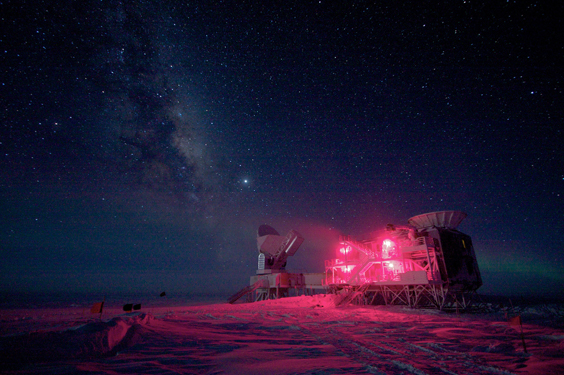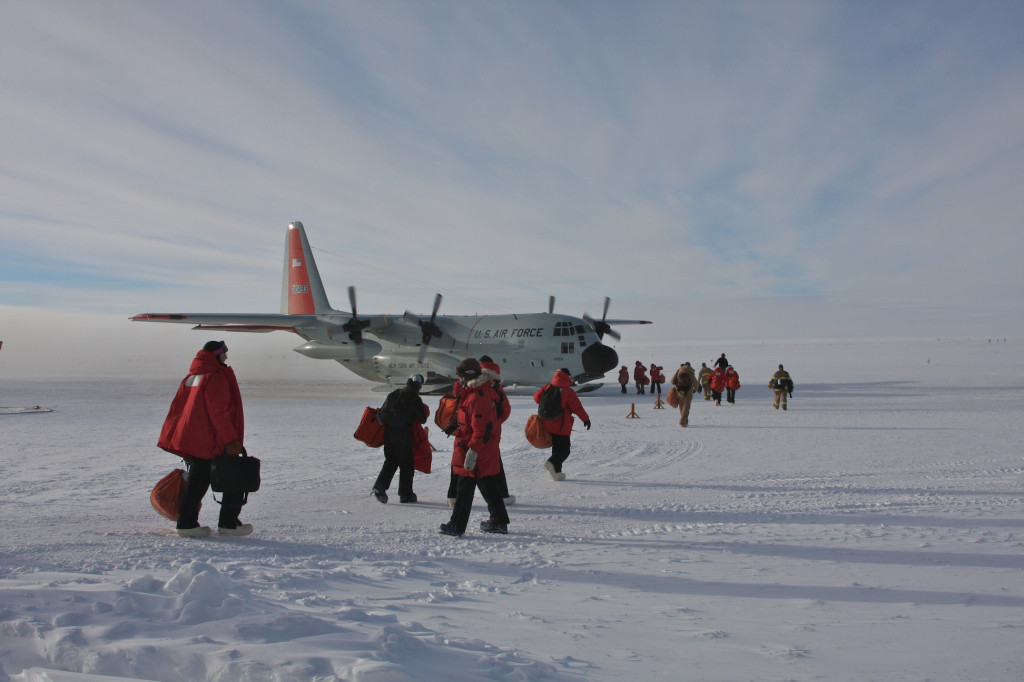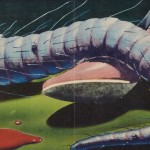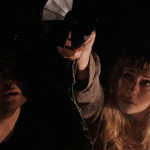A COLD NIGHT’S DEATH

The South Pole Telescope and BICEP (Background Imaging of Cosmic Extragalactic Polarization) telescope at Amundsen-Scott South Pole Station with the Milky Way in the night sky.
A freezing, barren wasteland is the backdrop for far-fetched fear in John Carpenter’s beloved classic The Thing, but the real life scientists who live and work in Antarctica must deal with issues that can be strikingly similar to those faced by the film’s doomed research team. Outpost 31 may not be a real place, but the paranoia, isolation and brutal weather that plagued R.J. MacReady (Kurt Russell) and his team can deeply affect the unprepared. And while there are no unknown life forms, brought to life by FX artist Rob Bottin or otherwise, dark matter has been discovered (which is possibly more terrifying).
Keith Vanderlinde knows these fears. Officially, Keith’s an experimental cosmologist/longwave length instrumentalist, but I prefer to think of him as a Canadian wizard. He conjures telescopes, with the help of other wizards like him. He lived and worked at the South Pole for one year, and provides unique insight into how the movie, released more than 30 years ago in June 1982, is uniquely relevant for those who make their living in the most remote and unforgiving regions of the globe.
Esinam Beckley: Can you just talk about and explain what exactly an experimental cosmologist/longwave length instrumentalist is/does?
Keith Vanderlinde: Well, I come from a background of physics. Studying how things work. Trying to come up with models of how the world fits together and how things interact. What the laws are that really underlie reality at the end of the day. In graduate school I got involved with cosmology, which is the study of not just the fundamental laws of nature, but fundamental laws, and how they apply in the largest possible scale. So if you have the universe as a whole you keep zooming out, and zooming out until you’re looking at the whole thing all at once. What do those laws actually manifest as? How do they influence the evolution of the universe and what makes it up? A cosmologist is really just someone who worries about that largest possible scale. An experimental cosmologist like me, we build telescopes, we make observations of the universe to try and answer questions, and test these theories.
EB: You work on two instruments. The South Pole telescope, and the Canadian Hydrogen Intensity Mapping Experiment. So you have an intimate relationship with these machines. What does this involve?
KV: Well cosmology is a pretty recent field, it’s only been around for maybe 20-25 years. Before that we had observations, we had some models, but the whole thing hadn’t really gelled into a coherent theory. It hadn’t really come together at the level that we’d like. A lot of the reason for that is that when you’re looking at these really large scales, you can’t use standard instruments. All of the normal things that we use in physics or in astrophysics are not quite right. The telescopes that we have tend to look at really small regions of sky where you want to look at the whole sky for most of cosmology. The South Pole telescope looks at microwave light. Turns out that the oldest light in the universe the cosmic microwave background, the picture of the earliest part of the universe that we can see, is all in microwaves. Normal telescopes don’t see microwaves. They see invisible light or maybe infrared light. So, really, to do modern cosmology starting 30 years ago, people decided that the only way to really do it was to build telescopes. So, I got involved 15 years ago now I guess. It was in one of these experiments where we went out and built a special telescope specifically to measure one exact thing about this cosmic microwave background. That’s really been the experience of the field since. So the way it works is that we look at the universe and we look at what the models are right now, we see if they’re making any interesting predictions that haven’t been tested and see if there are any big question marks open, and then we ask what we need to do to answer and test those things. Usually that involves some sort of piece of new equipment, some sort of telescope that doesn’t exist yet. So in the case of SPT we needed to build this microwave telescope, and to see microwaves from earth you have to stick it in the driest possible spot, which happens to be the South Pole. In the case of CHIME the Canadian hydro mapping intensity experiment which started maybe 10 years ago now, we wanted to map out this huge volume of the universe and make a three dimensional map of where all the structure is. When you write down all the possible ways of doing that this was one that made sense. To build a big radio telescope that looks at radio light from a huge chunk of the universe and there’s nothing like that on the planet now. So, we were forced to build it ourselves.
EB: Just because you’re used to working in physics, doesn’t necessarily mean you’d be at ease developing a whole machine that doesn’t even exist yet. Were you just thrown into it, and it was a matter of doing it because you had to? Or, was it a natural progression?
KV: It sort of varies, within physics there are two main streams. The experimental and the theoretical. The theorists tend to come up with models. They write down these mathematical descriptions of how things work and then they make predictions. The experimentalists build some new piece of hardware that check what the theorists are saying and see if it meshes with reality. If it’s the way the universe works, or if it isn’t. I got into experimental things back as an undergrad. I always had an aptitude for electronics and computers, and then in graduate school I got into cryogenics and all sorts of strange pieces of hardware. There is sort of a strain of people that goes into astrophysics, cosmology, and experimental physics. We just enjoy tinkering with things. So it is something that comes fairly naturally I guess. When you approach a new problem, you have no idea how to do it. You don’t have any of the necessary components, it takes a while to really build up an understanding and to figure out what it is that you need to do to address the question. That’s why I do it, it’s kind of fun. There are these puzzles out there and the whole world is your tool box to try and solve them.
EB: It sounds like from the beginning, you were someone intent on discovering, but how did you end up travelling to Antarctica and what was the decision making process like? Did you jump into it?
KV: I think I like exploring and adventures and things of that sort. When I was in graduate school I was working on this telescope that I mentioned. It was in New Jersey. Just refurbishing it putting a new microwave camera on it and making the whole thing into an experimental look at this cosmic microwave background. So that when I finished up graduate school, I was looking around for the next thing to do. This new telescope had just been built by some colleagues at the department I was at. It was just nearing completion at the South Pole. The South Pole is a funny place to work. You wouldn’t necessarily think of putting up a telescope there. It’s kind of hard to get to. It’s quite cold most of the year, and everything tends to break. The thing that makes it so great is that it is the driest place on earth. There’s plenty of water but it’s all frozen beneath you. So the air above you has no water whatsoever in it. This means that you can see a nice clear view of microwave light from outer space. Water absorbs microwave light very easily which is why microwave ovens work. They just have a microwave lightbulb in there that shines light onto your food, and heats up the food. That means if you want to make a picture of microwave light from space, you need to make sure you don’t have any water between you and it. Otherwise the water will just absorb it. Some people go to Chile, which is sort of the second driest place on the planet, and some people go to the South Pole which is the driest place on the planet. The problem with the driest place is that it gives you a nice clear view, and nothing works. Everything breaks constantly when it gets really really dry. So lubricants dry out and evaporate off telescopes. Especially if it’s minus a hundred out. They freeze, crack, fall off and evaporate. So they really need people to stay behind and maintain the instruments. The only way that this thing can keep running is with constant TLC. Someone has to be there to replace broken motors, to debug when anything goes wrong, and things go wrong kind of continuously. Any machine that will happen, but they put this machine at the bottom of the planet. It’s hard to fly people in periodically to service it. So I was finishing up grad school. They were looking for someone to go down and do this job. Stay behind, and maintain the telescopes throughout the winter. At the South Pole you can only fly in and out for the four months. In between the middle of November and the middle of February there are flights that come and go. After that, the station is closed and you’re stuck. For eight months of the year it’s inaccessible. The eight months are the best for observing. The darkest, driest, coldest months. You really have to leave someone behind to keep things running. So, I was finishing up grad school, not sure what I wanted to do next. I had a friend who had joined this project one day. They had mentioned they were looking for people to go down, and stay for the year. I just started talking to people and before I knew it, I was recruited.

The 60 people spending the winter at Amundsen-Scott South Pole Station pose for a group Midwinter photo. There is 24 hours of darkness during the winter months – this photo has been lightened using computer software.
EB: Before you went to the South Pole were there any prep classes? Someone to mentor you, and tell you what to expect?
KV: There’s not a lot of that. Nothing formal. They do put you through physical and mental tests to make sure you are not someone who is likely to either get a kidney stone, and be in serious trouble. That you’re not going to get severe cabin fever, or depression as a result of the dark. So they try to filter for those things. But then when you get down there you’re really reliant on the old timers. There are people who go down there year after year, and they’ll sort of explain to you what’s coming. You just take it a day at a time and go through the year. There’s a limited amount that can happen. It mostly just gets cold and dark.
EB: Considering physically exploring a new landscape, do you know a bit of history about the age of Antarctic exploration etc…?
KV: Yeah, back in the 1910s. The station there is actually called the Amundson and Scott South Pole station. Amundson and Scott were the two people who were racing to get to the South Pole. There’s pictures of them on the wall. There is some discussion, and people are vaguely aware of the history of what’s going on. The U.S. has kept a permanent occupation there for more than 50 years now I think. So after Amundson and Scott, it was essentially abandoned for fifty years. No one wanted to go back. Until Byrd flew in. He was a U.S. navy pilot. After that they went, and set up permanent shop.

The Dark Sector Lab at Amundsen-Scott South Pole Station houses experiments that study the evolution of the universe.
EB: What’s your set schedule like while you are there?
KV: In the summer it’s a madhouse of activity. There’s flights coming and going all the time. They have people on three different shifts. At any given time of day there’s activity. That’s partly because it’s always light out. What you call day is pretty arbitrary. You’re on sort of a 24/7 clock. People who are contracting there, people who are working as part of the station infrastructure. Whether its plumbers, chefs or doctors, they work standard shifts. Either day, night. In the winter pretty much everyone goes on to day shift. The scientists that are down there, or the beakers as they call us. We’re on our own schedule. So you can work any schedule you feel like working. Through the winter I usually kept a 24 hour shift. You know, working the day and working the evenings, and sleeping at night. Or, actually what we call day and night for social reason. It’s nice to line up with people. They only have meals during the day in winter. So it makes sense to try and stick on day shifts. In the summer when I was down there, I experimented with other shifts. I switched to a 36 hour day at one point. Staying up for 24 hours then sleeping for 12. You can get some different things done down there. It’s a weird thing to try and explain the sun being up all the time. It’s hard to wrap your head around what that does to your sleep schedule.
EB: I read that one of the hardest impacts is exactly that. That when you do finally get to see the sun again, it becomes a wondrous, huge event.
KV: Yeah I found the summer day/night thing way harder than the winter day/night things. Maybe it’s just living in Canada, and I’m used to short days or something. It being dark all the time wasn’t as difficult for me as when it was light all the time. When it was light all the time I couldn’t convince my brain to go to sleep. When it was dark all the time I can force myself to wake up more easily then I could force myself to sleep.
EB: I heard there was a tradition of two particular films being watched before the last flight goes out. Can you talk about that?
KV: During winter the night after the last flight. It’s when the end of summer flight leaves and you’re not expecting another flight for eight more months. You winterize the station, you get everything ready, and it takes about a week. The first night after that, everyone gathers in the gym, puts on the projector, and watches John Carpenter’s The Thing on a big screen. Just to see what we’re in for. Then, in the middle of winter, the dark period, we have a celebration. There’s a big dinner, everyone takes a day off. As part of that, everyone gathers in the gym again, and you watch The Shining. By that point it rings surprisingly true.
EB: So you can relate to the themes of isolation, and particular impacts on the mind and body?
KV: By that point in the winter you are starting to feel a bit of that. Of course not severe paranoia, but when you’re around people all the time, everyone gets cabin fever. Everyone starts to a little stir crazy. There’s a special name we have there for that. We call it getting toasty. You can see it in wild eyes, thousand mile stares, people become very quick to anger. There’s all sorts of things that go along with being toasty. I wasn’t entirely kidding when I said things like The Shining sort of start to ring true. A lot of the issues of social isolation. You experience by then, and you really do start to identify with them a bit.
EB: You’re with other scientists and people you trust. Unknown life forms are not a concern to you. However, I read about the ‘’winter over syndrome.’’ At any point, did you happen to feel the impacts of this syndrome?
KV: One of the effects is that people’s sleep patterns get pretty disrupted. Some people become narcoleptic and sleep all the time. Some people become insomniacs and can’t get to sleep. It tends to wear down nerves. So people get more severe cabin fever. As the year progresses, you go through phases where everyone is very social, and very anti-social. The first month after they close the station everyone wants to get to know each other and there are lot of evening gatherings, volley ball teams, board games, and bands that form. After a few months they all sort of die off, and everyone just hides in their room. When you have time off you sort of just go in your room and stay quietly in the corner. After a couple months of that people get lonely, and come out and there’s another active period. It comes and goes in waves. I certainly noticed after a while I just wanted to be left alone, and have a little bit of private space. I was lucky since I had a telescope to go to. The telescope I was working on was about a kilometre away from the station. Most people are essentially confined to the station because you have nowhere else to go. People tend to wear on each other after a while and not being able to get away is really tough.

Auroras play over the South Pole Telescope experiment at Amundsen-Scott South Pole Station. The experiment collects data about the evolution of the early universe using “fossil” light left over from the Big Bang called cosmic microwave background.
EB: I read you worked developing exhibits for the museum of science and industry so you’re a bit of an artist too? Or, were you working with them to direct technical details?
KV: Yeah! Years ago, back in graduate school. I worked with a couple different museums. I did some of the artwork. I don’t think I’m an artist particularly, but I had some creative juices flowing at the time. I developed a couple exhibits for the museum of science and history in Chicago. One for the Adler planetarium. A couple were used in travelling shows for a while, for smaller science museums around the area. I had a lot of fun with that. My view is that science isn’t really finished until all the information is disseminated. We’re supposed to be coming up with these models of how things work, testing the models, and then what? You have to feed it back, or there’s no meaning to the whole thing. If the information is dropped, I feel like you haven’t really done your job. So I really do enjoy the giving back to the community. It’s not something I do out of the goodness of my heart. It’s because I really do think that’s part of the job. It helps society for everyone to really understand what’s happening out there. It’s valuable for us to understand our place, our context, where we come from where we’re going to on all scales.
EB: In the film The Thing Kurt Russell’s character makes some pretty unsettling discoveries about the world around him. Since you’ve started as a researcher are there any discoveries that have changed your perspective?
KV: That’s a good question. Coming to terms with my own understanding of stuff that was largely sorted out by the time I got here is a lot of it. Wrapping your brain around how the universe actually works. We’re in this amazing, expanding space, full of strange things. You know, 95% of the stuff in the universe is stuff we had no idea existed. Fifty years ago certainly, even 20 years ago we didn’t know three quarters of it was there. We still have no idea what it is. That’s the stuff I’m studying now. Partly it’s developing historical stuff. As far as eureka moments where new and unexpected things were discovered in my career. The biggest was probably in ’98 when they discovered dark energy. They discovered the universe is not only expanding, but the expansion is accelerating. Apparently in an undoubted way that the universe will someday tear itself apart. That’s the stuff I’m trying to measure properties in more detail to see if that’s actually where we’re going or what’s happening there. To most physicists that was the largest surprise. That three quarters of the energy density of the universe is in a strange substance that is unlike anything else we’ve ever come across. That is leading the universe to expand in this accelerated and unbounded way, and that is weird! It’s not what I naively expected. It came as a surprise to a lot of people. The world is a funny place. The universe is a funnier one.
Photos by Dr. Keith Vanderlinde, courtesy of The National Science Foundation.

 July 3, 2017
July 3, 2017  No Comments
No Comments












